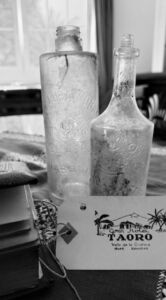To mark the Agatha Christie Festival (organized by the CIT Puerto de la Cruz), which this week fills the streets of our city with mystery and culture, we want to share a small discovery that has transported us to the past of the Gran Hotel Taoro and, with it, to the early days of our family’s history in Tenerife.
The Scent of Time
When the 10th edition of the Agatha Christie Festival begins in Puerto de la Cruz, the air seems heavier, as if it carries with it the echoes of a bygone era. Among the palm trees in the Taoro gardens, the sound of footsteps from former guests mingles with the Atlantic breeze. It was there, in that majestic hotel overlooking the valley, that Agatha Christie found both tranquility and mystery. And it was also there, among the corridors of the Taoro, that a young German manager, Enrique Talg Schulz, worked, who would one day build his own dream on this very hill: the Hotel Tigaiga.
And it was in the area known as the Carolina Garden where the staff of the Grand Hotel changed before starting their shifts; their days passed there amidst the bustle of the service and the murmur of the guests. Today, that corner is silence and greenery, but it recently revealed a secret to us. When the soil was disturbed in recent years, old bottles appeared, covered by a patina of time, as if they had been waiting to be found. They are transparent bottles with the front embossed in the glass itself with molded letters in understated capitals, an Art Deco typeface: clean lines and regular spacing.
On one, you can still read the name Ed. Pinaud, the Parisian firm founded in 1830 that perfumed the Belle Époque with elegant colognes and lotions, used on ships and in luxury hotels around the world. Perhaps that bottle belonged to a chambermaid who dreamed of smelling of roses instead of soap, or to an English guest who wrote perfumed letters at dusk. Perhaps, who knows, one of them left its fragrance in the air as Agatha Christie walked through the lobby, observing with her novelist’s eye the human theater that so inspired her stories.
On another bottle, we discover the text in clear lettering of Crusellas y Cía., made in Havana. Its round shape and clear glass reveal that it was manufactured between 1910 and 1930, a time when the Crusellas house began producing more delicate bottles to highlight the color of the perfume. It contained one of its most popular fragrances: “A la Flora Cubana,” a floral cologne that crossed oceans carrying with it the exoticism of the Caribbean.
To think that these bottles rested in the surroundings of the old Taoro, where Agatha Christie breathed inspiration and Enrique Talg dreamed of his future hotel, fills us with wonder. Perhaps one of those essences perfumed a dressing table, a letter, or a moment lost to time.
Today, those bottles rest among us once more, silent witnesses to an era when luxury smelled of flowers, and elegance traveled in glass flasks. With each discovery, we feel the past return to perfume our present: a living memory nestled between the gardens of Taoro and the spirit of Tigaiga.



